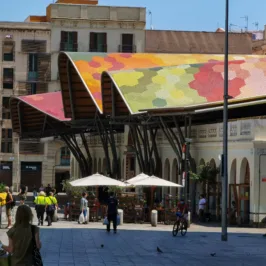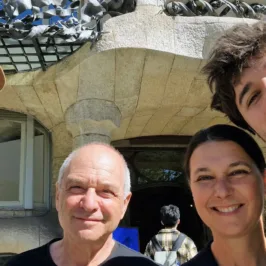Barcelona is re-designing its streets.

Barcelona city planners released a new plan that takes city spaces back from cars, for the people. Re-orienting the city to the human scale, Barcelona’s leaders have decided to create more space for walking and cycling, while leaving less space for traffic jams. The goal is that this transformation will increase Barcelona residents’ access to the city, with new areas for recreation and social interaction along the historic city streets.
The new plan will return 60% of the space of the streets where cars circulate today to the citizens for pedestrian use. The city has an ambitious plan for the redesign of the blocks of neighborhoods, turning them into “super-blocks.” The idea is to join nine city blocks into one, forming a square. The cars on the internal streets will be replaced by boardwalks, bike paths, recreational areas and green areas. The Eixample district will be the first to participate in the project.
The design of the “super-blocks” will humanize public space, as it takes into consideration livability, sustainable mobility, green areas and biodiversity, while aiming to promote citizen participation. Local government leaders aim to create public spaces for the people, emphasizing social interaction, health and recreation for all. The measures, in addition to benefiting residents, are aligned with urban sustainability goals. The design of “super-blocks” re-organizes city streets to be oriented toward sustainable mobility options, like walking, cycling and using public transport.
Through the new design, cars, motorcycles and buses are restricted to the streets outside the perimeter of the blocks, while private vehicles will have even greater restrictions. People who own a car and live in areas restricted to pedestrians will be able to access the internal roads, but only at reduced speeds of 10 kilometers per hour, thus reducing overall congestion and the likelihood of fatal traffic crashes. From the point of view of urban planning, Barcelona’s approach to compact neighborhoods and plans for mixed urban land use is aligned with the recommendations outlined in the Manual for Transit-Oriented Development, also referred to as DOTS. This approach enhances green spaces for citizens, encouraging social interaction and healthy modes of transport.
A study released by the Environmental Epidemiology Agency determined that last year, about 1,200 deaths could have been avoided if Barcelona met the air quality standards recommended by the European Union. The study cites 18,700 hospital cases of preventable asthma attacks, as well as 12,100 cases of acute bronchitis and 600 hospitalizations related to cardiovascular problems. In addition, the city traffic is responsible for elevated noise levels, which have reached a level 61% higher than what is considered healthy by law.
However, the improvement of urban spaces for citizens depends on how the plan will be implemented. The project consists of adding over 300km of bike paths to existing cycling infrastructure. In addition, the city has a bus network servicing many of its main roads. Salvador Rueda, director of the Barcelona’s Urban Ecology Agency has predicted that these measures will ensure that buses have rapid and reliable service for public transport users across the city.
The new designs will be installed in nine different places across Barcelona, with an estimated project cost of €10 million. Barcelona is pioneering its urban development, using tactical urbanism to create healthier, more sustainable city spaces that are accessible to all. Returning city streets to the people, Barcelona is re-examining what a city block can be.









Leave a Reply